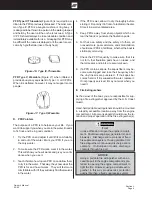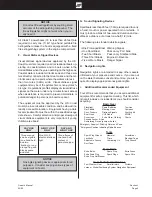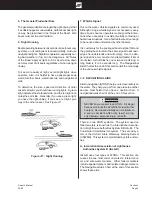
Owner’s Manual
05/00
Section H
Page 3
(ABYC) technical information report: “Educational In-
formation About Carbon Monoxide”. This information
pertains to all boats manufactured by Four Winns.
NOTICE
The boat owner should be aware that other fac-
tors may contribute to carbon monoxide accu-
mulation. The most common ones are listed in
this section. If a person is exhibiting carbon
monoxide-type symptoms (Refer to Section F
Symptoms), be sure to take the necessary pre-
cautions as prescribed later in this section.
NOTICE
Boats fueled by diesel have limited carbon mon-
oxide present in the exhaust in comparison to
gasoline engine exhaust. However, the boat
owner should still be aware of the causes and
effects of carbon monoxide which may occur in
different boating situations.
A. Definition of Carbon Monoxide
1.
Carbon Monoxide: Carbon Monoxide (CO) is a gas
formed by the combination of one molecule of car-
bon and one molecule of oxygen. Chemists refer to
it as CO, its chemical formula, “C” for carbon and
“O” for oxygen.
2.
COHb: Carboxyhemoglobin is the molecule formed
when Carbon Monoxide combines with blood instead
of oxygen.
B. Properties and Characteristics of Carbon Mon-
oxide
1.
Carbon Monoxide is a colorless, odorless and taste-
less gas.
2.
Its weight is about the same as air so it cannot be
expected to rise or fall like some other gases, but
will distribute itself throughout the space.
NOTICE
DO NOT rely on the use of smell or sight to de-
tect CO, because it diffuses in the air much more
rapidly than easily detectable (visible and odor-
ous) gases.
C. What Makes Carbon Monoxide
Any time a material containing carbon burns such as
gasoline, natural gas, oil, propane, coal, or wood, CO is
produced.
Common sources of carbon monoxide are:
1.
Internal combustion engines.
2.
Open flame devices such as:
a.
Cooking ranges
b.
Central heating plants
c.
Space heaters
d.
Water heaters
e.
Fireplaces
f.
Charcoal grills
D. How a Person is Affected by Carbon Monoxide
Carbon monoxide is absorbed by the lungs and reacts
with blood hemoglobin to form carboxyhemoglobin, which
reduces the oxygen carrying capacity of the blood. The
result is a lack of oxygen for the tissues with the subse-
quent tissue death and, if prolonged, death of the in-
dividual.
E. Effects of Carbon Monoxide
Carbon monoxide in high concentrations can be fatal in
a matter of minutes. Lower concentrations must not be
ignored because the effects of exposure to CO are cu-
mulative and can be just as lethal.
Certain health related problems and age will increase
the effects of CO. People who smoke or are exposed to
high concentrations of cigarette smoke, consume alco-
hol or have lung disorders or heart problems, are par-
ticularly susceptible to an increase in the effects from
CO. However, all occupants’ health should be consid-
ered. Physical exertion accelerates the rate at which
the blood absorbs CO.
Summary of Contents for Horizon 200
Page 1: ......
Page 56: ...Owner s Manual 05 00 Section G Page 6 Figure G7 General Water System Diagram WATER SYSTEM ...
Page 80: ...Owner s Manual 05 00 Section J Page 15 Figure J16 Skiing Signals ...
Page 131: ...Owner s Manual 05 00 Fuel Log Page 1 FUEL LOG DATE HOURS RUN FUEL GAL RANGE MILES RPM MPH GPH ...
Page 132: ...Owner s Manual 05 00 Fuel Log Page 2 FUEL LOG DATE HOURS RUN FUEL GAL RANGE MILES RPM MPH GPH ...
Page 133: ...Owner s Manual 05 00 Fuel Log Page 3 FUEL LOG DATE HOURS RUN FUEL GAL RANGE MILES RPM MPH GPH ...
Page 134: ...Owner s Manual 05 00 Service Log Page 1 SERVICE LOG DATE HOURS MAINTENANCE PERFORMED ...
Page 135: ...Owner s Manual 05 00 Service Log Page 2 SERVICE LOG DATE HOURS MAINTENANCE PERFORMED ...
Page 136: ...Owner s Manual 05 00 Service Log Page 3 SERVICE LOG DATE HOURS MAINTENANCE PERFORMED ...
Page 138: ...Page 1 1998 1999 MODEL YEAR 200 HORIZON 245 SUNDOWNER Electrical Schematics ...
Page 140: ......






























